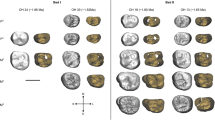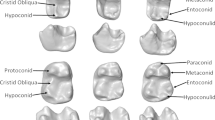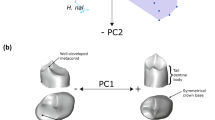Abstract
Molar morphology plays a key role in the systematics and behavioral interpretation of fossil taxa, so understanding the developmental patterns that shape occlusal morphology in modern taxa is of central importance to informing analysis of the fossil record. The shape of the outer enamel surface (OES) of a tooth is largely the result of the forming and folding of the inner enamel epithelium, which is preserved in fully formed teeth as the enamel-dentine junction (EDJ). Previous research on living primates has shown that the degree of correlation between the EDJ and OES can be used to inform our understanding of developmental patterns because lower correlations imply that later developmental events modify the template provided by the EDJ more extensively. Here, we use three topographic metrics to investigate the degree of correlation between the EDJ and OES across living euarchontans by analyzing treeshrews and dermopterans in addition to primates. We found that all living euarchontans show a high degree of topographical correlation, whereas non-primates, especially basally divergent taxa such as Ptilocercus lowii, show the highest degree of correlation between these two surfaces. Our results indicate, that while it is the earlier stages of dental development that have the most influence on overall crown morphology in euarchontans generally, among primates, anthropoids have a lower degree of correlation, implying a greater emphasis on later phases of dental development. This provides insight relevant to interpreting the evolutionary context of the diversity of dental form observed within Euarchonta.




Similar content being viewed by others
References
Anemone RL, Skinner MM, Dirks W (2012) Are there two distinct types of hypocone in Eocene primates? The “pseudohypocone” of notharctines revisited. Palaeontol Electron 15.3.26A
Bailey SE, Skinner MM, Hublin J-J (2011) What lies beneath? An evaluation of lower molar trigonid crest patterns based on both dentine and enamel expression. Am J Phys Anthropol 145:505–518
Beard KC (1991) Vertical postures and climbing in the morphotype of Primatomorpha: implications for locomotor evolution in primate history. In: Coppens Y, Senut B (eds) Origines de la Bipédie chez les Hominidés (Cahiers de Paleoanthropologie). Editions du CNRS, Paris, pp 79–87
Berthaume MA (2015) Hominoid dental topography: a possible case for character displacement. Am J Phys Anthropol S60:84
Boyer DM (2008) Relief index of second mandibular molars is a correlate of diet among prosimian primates and other euarchontan mammals. J Hum Evol 55:1118–1137
Boyer DM, Costeur L, Lipman Y (2012) Earliest record of Platychoerops (Primates, Plesiadapidae), a new species from Mouras quarry, Mont de Berru, France. Am J Phys Anthropol 149:329–346
Boyer DM, Evans AR, Jernvall J (2010) Evidence of dietary differentiation among late Paleocene-early Eocene plesiadapids (Mammalia, Primates). Am J Phys Anthropol 142:194–210
Boyer DM, Gunnell GF, Kaufman S, McGeary T (2016) MorphoSource–archiving and sharing 3D digital specimen data. J Paleontol 22:157–181
Bunn JM, Boyer DM, Lipman Y, St. Clair EM, Jernvall J, Daubechies I (2011) Comparing Dirichlet normal surface energy of tooth crowns, a new technique of molar shape quantification for dietary inference, with previous methods in isolation and in combination. Am J Phys Anthropol 145:247–261
Butler PM (1956) The ontogeny of molar pattern. Biol Rev 31:30–69
Corruccini RS (1987) The dentinoenamel junction in primates. Internatl J Primatol 8:99–114
Corruccini RS (1998) The dentino-enamel junction in primate mandibular molars. In: Lukacs JD (ed) Human Dental Development, Morphology and Pathology: A Tribute to Albert A. Dahlberg. University of Oregon Anthropological Papers, Vol. 54, University of Oregon, Portland, pp 1–16
Dennis JC, Ungar PS, Teaford MF, Glander KE (2004) Dental topography and molar wear in Alouatta palliata from Costa Rica. Am J Phys Anthropol 125:152–161
Evans AR, Jernvall J (2009) Patterns and constraints in carnivoran and rodent dental complexity and tooth size. J Vertebr Paleontol 29:24A
Evans AR, Wilson GP, Fortelius M, Jernvall J (2007) High-level similarity of dentitions in carnivorans and rodents. Nature 445:78–81
Felsenstein J (1985) Phylogenies and the comparative method. Am Nat 125:1–15
Godfrey LR, Winchester JM, King SJ, Boyer DM, Jernvall J (2012) Dental topography indicates ecological contraction of lemur communities. Am J Phys Anthropol 148:215–227
Guy F, Gouvard F, Boistel R, Euriat A, Lazzari V (2013) Prospective in (primate) dental analysis through tooth 3D topographical quantification. PLoS One 8:e66142
Guy F, Lazzari V, Gilissen E, Thiery G (2015) To what extent is primate second molar enamel occlusal morphology shaped by the enamel-dentine junction? PLoS One 10:e0138802
Hammer Ø, Harper DAT, Ryan PD (2001) PAST: paleontological statistics software package for education and data analysis. Palaeontol Electron 4
Harrington L, Armstrong SD, Churms C (2012) A micro-CT study of the canine mesial ridge (Bushman’s Canine) in later Stone Age dentitions. Poster presented at the Canadian Association for Physical Anthropology
Janečka JE, Miller W, Pringle TH, Wiens F, Zitzmann A, Helgen KM, Springer MS, Murphy WJ (2007) Molecular and genomic data identify the closest living relative of primates. Science 318:792–794
Korenhof CAW (1960) Morphogenetical Aspects of the Human Upper Molar: A Comparative Study of its Enamel and Dentine Surfaces and their Relationship to the Crown Pattern of Fossil and Recent Primates. Uitgeversmaatschappij Neerlandia, Utrecht
Korenhof CAW (1961) The enamel-dentine border: a new morphological factor in the study of the (human) molar pattern. Proc Koninkl Nederl Acad Wetensch 64:639–664
Korenhof CAW (1978) Remnants of the trigonid crests in medieval molars of man of Java. In: Butler PM, Joysey K (eds) Development, Function and Evolution of Teeth. Academic Press, New York, pp 157–169
Korenhof CAW (1982) Evolutionary trends of the inner enamel anatomy of deciduous molars from Sangiran (Java, Indonesia). In: Kurtén B (ed) Teeth: Form, Function and Evolution. Columbia University Press, New York, pp 350–365
Kraus BS (1952) Morphologic relationships between enamel and dentin surfaces of lower first molar teeth. J Dent Res 31:248–256
Kraus BS, Jordan RE (1965) The Human Dentition Before Birth. Lea & Febiger, Philadelphia
Li Q, Ni X (2016) An early Oligocene fossil demonstrates treeshrews are slowly evolving “living fossils.” Sci Rep 6:18627
Liu L, Yu L, Pearl DK, Edwards SV (2009) Estimating species phylogenies using coalescence times among sequences. Syst Biol 58:468–477
López-Torres S, Selig KR, Prufrock KA, Lin D, Silcox MT (2017) Dental topographic analysis of paromomyid (Plesiadapiformes, Primates) cheek teeth: more than 15 million years of changing surfaces and shifting ecologies. Hist Biol 30:76–88
Maddison W, Maddison D (2017) Mesquite: a modular system for evolutionary analysis. Version 3.2. Available from http://mesquiteproject.org
Martin RMG, Hublin J-J, Gunz P, Skinner MM (2017) The morphology of the enamel–dentine junction in Neanderthal molars: gross morphology, non-metric traits, and temporal trends. J Hum Evol 103:20–44
Martínez de Pinillos M, Martinón-Torres M, Skinner MM, Arsuaga JL, Gracia-Téllez A, Martínez I, Martín-Francés L, Bermúdez de Castro JM (2014) Trigonid crests expression in Atapuerca-Sima de los Huesos lower molars: internal and external morphological expression and evolutionary inferences. CR Palevol 13:205–221
Mason VC, Li G, Minx P, Schmitz J, Churakov G, Doronina L, Melin AD, Dominy NJ, Lim NT-L, Springer MS, Wilson RK, Warren WC, Helgen KM, Murphy WJ (2016) Genomic analysis reveals hidden biodiversity within colugos, the sister group to primates. Sci Adv 2:e1600633
M’Kirera F, Ungar PS (2003) Occlusal relief changes with molar wear in Pan troglodytes troglodytes and Gorilla gorilla gorilla. Am J Primatol 60:31–41
Morita W (2016) Morphological comparison of the enamel–dentine junction and outer enamel surface of molars using a micro-computed tomography technique. J Oral Biosci 58:95—99
Ni X, Gebo DL, Dagosto M, Meng J, Tafforeau P, Flynn JJ, Beard KC (2013) The oldest known primate skeleton and early haplorhine evolution. Nature 498:60–64
Ni X, Li Q, Li L, Beard KC (2016) Oligocene primates from China reveal divergence between African and Asian primate evolution. Science 352:673–677
Ni X, Qiu Z (2012) Tupaiine tree shrews (Scandentia, Mammalia) from the Yuanmou Lufengpithecus locality of Yunnan, China. Swiss J Palaeontol 131:51–60
O’Leary MA, Bloch JI, Flynn JJ, Gaudin TJ, Giallombardo A, Giannini NP, Goldberg SL, Kraatz BP, Luo Z-X, Meng J, Ni X, Novacek MJ, Perini FA, Randall ZS, Rougier GW, Sargis EJ, Silcox MT, Simmons NB, Spaulding M, Velazco PM, Weksler M, Wible JR, Cirranello AL (2013) The placental mammal ancestor and the post–K-Pg radiation of placentals. Science 339:662–667
Olejniczak AJ, Gilbert CC, Martin LB, Smith TM, Ulhaas L, Grine FE (2007) Morphology of the enamel-dentine junction in sections of anthropoid primate maxillary molars. J Hum Evol 53:292–301
Olejniczak AJ, Martin LB, Ulhaas L (2004) Quantification of dentine shape in anthropoid primates. Ann Anat-Anat Anz 186:479–485
Olson LE, Sargis EJ, Martin RD (2005) Intraordinal phylogenetics of treeshrews (Mammalia: Scandentia) based on evidence from the mitochondrial 12S rRNA gene. Mol Phylogenet Evol 35:656–673
Ortiz A, Skinner MM, Bailey SE, Hublin J-J (2012) Carabelli’s trait revisited: an examination of mesiolingual features at the enamel–dentine junction and enamel surface of Pan and Homo sapiens upper molars. J Hum Evol 63:586–596
Pampush JD, Spradley JP, Morse PE, Harrington AR, Allen KL, Boyer DM, Kay RF (2016a) Wear and its effects on dental topography measures in howling monkeys (Alouatta palliata). Am J Phys Anthropol 161:705—721
Pampush JD, Winchester JM, Morse PE, Vining AQ, Boyer DM, Kay RF (2016b) Introducing molaR: a new R package for quantitative topographic analysis of teeth (and other topographic surfaces). J Mammal Evol 23:397–412
Prufrock KA, Boyer DM, Silcox MT (2016a) The first major primate extinction: an evaluation of paleoecological dynamics of North American stem primates using a homology free measure of tooth shape. Am J Phys Anthropol 159:683–697
Prufrock KA, López-Torres S, Silcox MT, Boyer DM (2016b) Surfaces and spaces: troubleshooting the study of dietary niche space overlap between North American stem primates and rodents. Surf Topogr Metrol Prop 4:024005
Qiu Z (1986) Fossil tupaiid from the hominoid locality of Lufeng, Yunnan. Vertebr PalAsiatica 24:308–319
Roberts TE, Lanier HC, Sargis EJ, Olson LE (2011) Molecular phylogeny of treeshrews (Mammalia: Scandentia) and the timescale of diversification in Southeast Asia. Mol Phylogenet Evol 60:358–372
Schwartz GT, Thackeray JF, Reid C, van Reenan JF (1998) Enamel thickness and the topography of the enamel–dentine junction in South African Plio-Pleistocene hominids with special reference to the Carabelli trait. J Hum Evol 35:523–542
Skinner MM (2008) Enamel-dentine junction morphology of extant hominoid and fossil hominin lower molars. PhD Dissertation, George Washington University, Washington, D.C.
Skinner MM, Evans A, Smith T, Jernvall J, Tafforeau P, Kupczik K, Olejniczak AJ, Rosas A, Radovčić J, Thackeray JF, Toussaint M, Hublin J-J (2010) Brief communication: contributions of enamel-dentine junction shape and enamel deposition to primate molar crown complexity. Am J Phys Anthropol 142:157–163
Skinner MM, Gunz P, Wood BA, Boesch C, Hublin J-J (2009a) Discrimination of extant Pan species and subspecies using the enamel–dentine junction morphology of lower molars. Am J Phys Anthropol 140:234–243
Skinner MM, Gunz P, Wood BA, Hublin J-J (2008a) Enamel-dentine junction (EDJ) morphology distinguishes the lower molars of Australopithecus africanus and Paranthropus robustus. J Hum Evol 55:979–988
Skinner MM, Gunz P, Wood BA, Hublin J-J (2009b) How many landmarks? Assessing the classification accuracy of Pan lower molars using a geometric morphometric analysis of the occlusal basin as seen at the enamel-dentine junction. In: Koppe T, Meyer G, Alt KW (eds) Comparative Dental Morphology. Karger, Basel, pp 23–29
Skinner MM, Wood BA, Boesch C, Olejniczak AJ, Rosas A, Smith TM, Hublin J-J (2008b) Dental trait expression at the enamel-dentine junction of lower molars in extant and fossil hominoids. J Hum Evol 54:173–186
Skinner MM, Wood BA, Hublin J-J (2009c) Protostylid expression at the enamel-dentine junction and enamel surface of mandibular molars of Paranthropus robustus and Australopithecus africanus. J Hum Evol 56:76–85
Smith TM, Olejniczak AJ, Reid DJ, Ferrell RJ, Hublin J-J (2006) Modern human molar enamel thickness and enamel–dentine junction shape. Arch Oral Biol 51:974–995
Spradley JP, Pampush JD, Morse PE, Kay RF (2017) Smooth operator: the effects of different 3D mesh retriangulation protocols on the computation of Dirichlet normal energy. Am J Phys Anthropol 163:94–109
Springer MS, Meredith RW, Gatesy J, Emerling CA, Park J, Rabosky DL, Stadler T, Steiner C, Ryder OA, Janečka JE, Fisher CA, Murphy WJ (2012) Macroevolutionary dynamics and historical biogeography of primate diversification inferred from a species supermatrix. PLoS One 7:e49521
Springer MS, Stanhope MJ, Madsen O, de Jong WW (2004) Molecules consolidate the placental mammal tree. Trends Ecol Evol 19: 430–438
Swofford DL, Maddison WP (1992) Parsimony, character-state reconstructions, and evolutionary inferences. In: Mayden RL (ed) Systematics, Historical Ecology and North American Freshwater Fishes. Stanford University Press, Stanford, pp 186–223
Thiery G, Lazzari V, Ramdarshan A, Guy F (2017) Beyond the map: enamel distribution characterized from 3D dental topography. Front Physiol 8:524
Ulhaas L, Kullmer O, Schrenk F, Henke W (2004) A new 3-D approach to determine functional morphology of cercopithecoid molars. Ann Anat- Anat Anz 186:487–493
Ungar PS, M’Kirera F (2003) A solution to the worn tooth conundrum in primate functional anatomy. Proc Natl Acad Sci USA 100:3874–3877
Ungar PS, Williamson M (2000) Exploring the effects of tooth wear on functional morphology: a preliminary study using dental topographic analysis. Palaeontol Electron 3:18
Visualization Sciences Group (2009) Avizo. Mercury Computer Systems, Burlington
Waddell PJ, Okada N, Hasegawa M (1999) Towards resolving the interordinal relationships of placental mammals. Syst Biol 48:1–5
Wilson GP, Evans AR, Corfe IJ, Smits PD, Fortelius M, Jernvall J (2012) Adaptive radiation of multituberculate mammals before the extinction of dinosaurs. Nature. 483:457—460
Winchester JM (2016) MorphoTester: an open source application for morphological topographic analysis. PLoS One 11:e0147649
Winchester JM, Boyer DM, St. Clair EM, Gosselin-Ildari AD, Cooke SB, Ledogar JA (2014) Dental topography of platyrrhines and prosimians: convergence and contrasts. Am J Phys Anthropol 153:29–44
Acknowledgments
The authors would like to thank MA Schillaci for comments on an earlier version of this manuscript as well as two anonymous reviewers for their helpful comments. We thank SGB Chester for generously sharing scans and DM Boyer for sharing scans and helping with MorphoSource. We thank Larry Heaney of The Field Museum of Natural History for providing access to treeshrew specimens as well as curators and collections staff at the American Museum of Natural History, Duke Department of Evolutionary Anthropology, Harvard Museum of Comparative Zoology, the United States National Museum, Smithsonian Institution, and the Max Planck Florida Institute of Neuroscience for allowing upload of scans of specimens to MorphoSource. This research was supported by a grant from the University of Toronto Scarborough International Research Collaboration Fund and an NSERC Discovery Grant to MTS.
Institutional Abbreviations
AMNH American Museum of Natural History, New York, NY, USA; EA Duke University, Evolutionary Anthropology, Durham, NC, USA; FMNH The Field Museum of Natural History, Chicago, IL, USA; MCZ Museum of Comparative Zoology, Harvard University, Cambridge, MA, USA; MPFIN Max Planck Florida Institute of Neuroscience, Jupiter, FL, USA; USNM United States National Museum, Smithsonian Institution, Washington, DC, USA
Author information
Authors and Affiliations
Corresponding author
Electronic supplementary material
ESM 1
(PDF 843 kb)
Rights and permissions
About this article
Cite this article
Selig, K.R., López-Torres, S., Sargis, E.J. et al. First 3D Dental Topographic Analysis of the Enamel-Dentine Junction in Non-Primate Euarchontans: Contribution of the Enamel-Dentine Junction to Molar Morphology. J Mammal Evol 26, 587–598 (2019). https://doi.org/10.1007/s10914-018-9440-2
Published:
Issue Date:
DOI: https://doi.org/10.1007/s10914-018-9440-2




